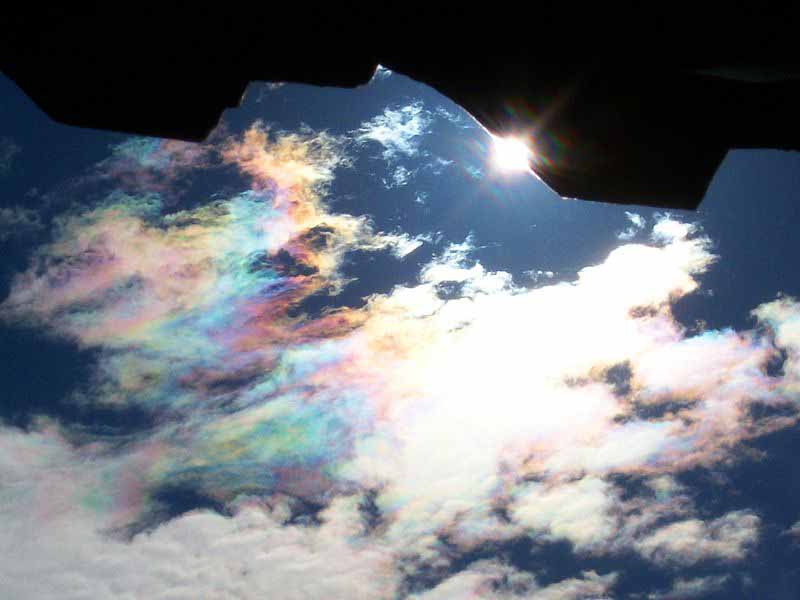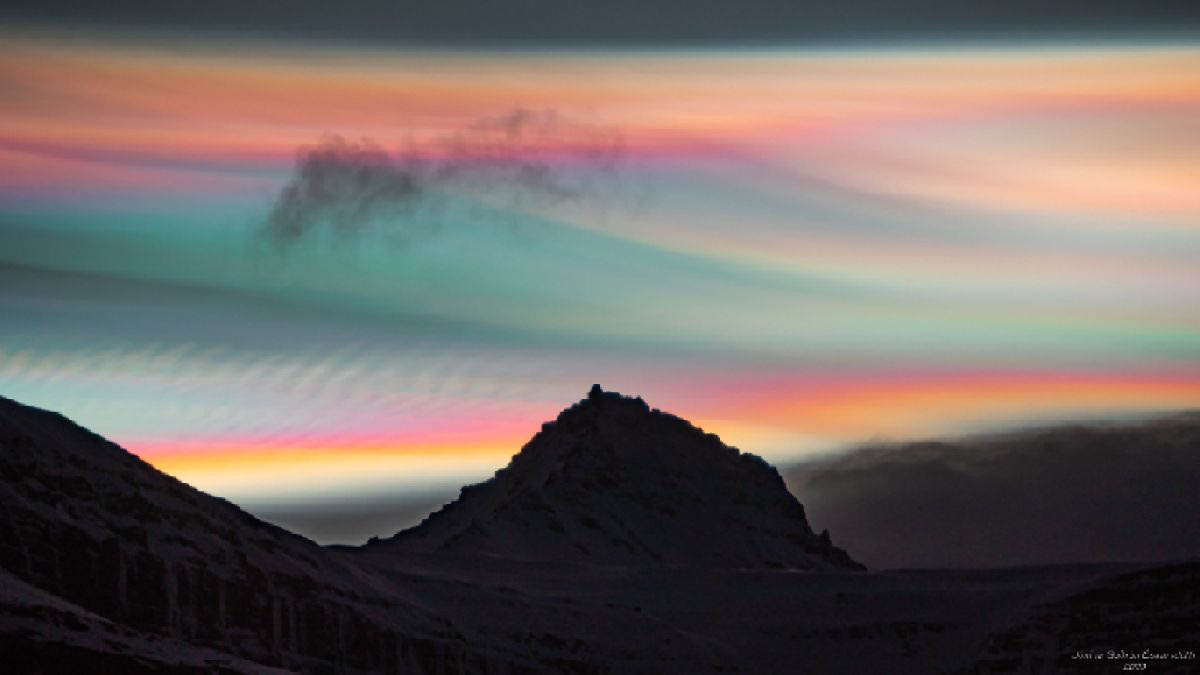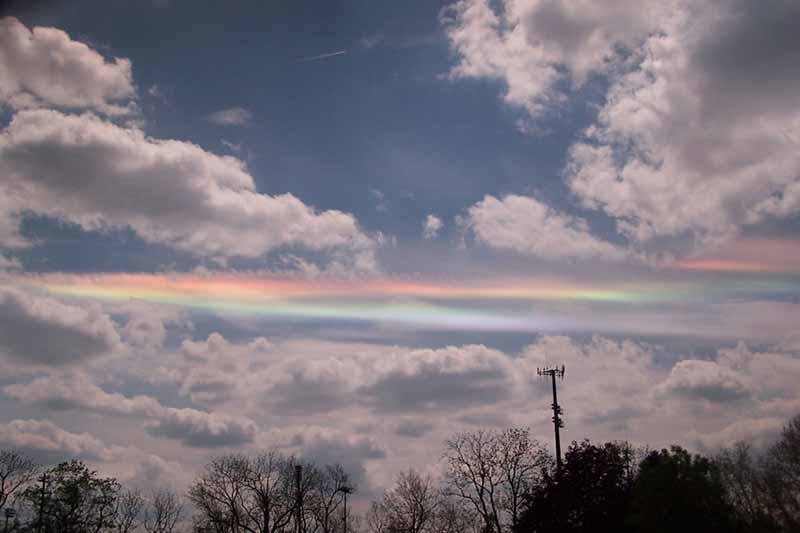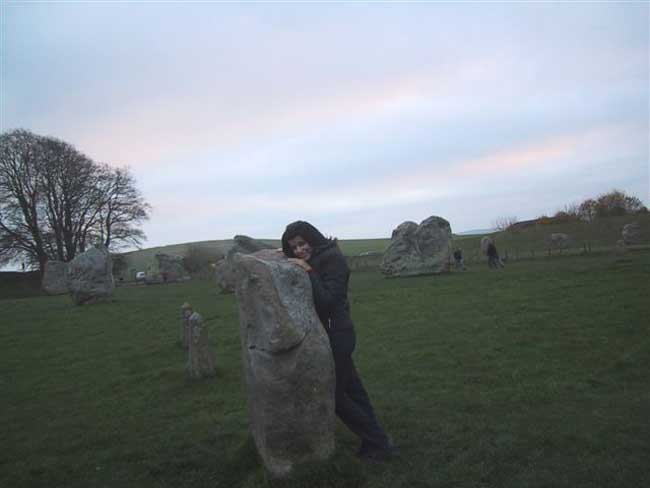

Cloud iridescence is a colorful optical phenomenon that occurs in a cloud and appears in the general proximity of the Sun or Moon. The colors resemble those seen in soap bubbles and oil on a water surface. This fairly common phenomenon is most often observed in altocumulus, cirrocumulus, lenticular, and cirrus clouds. Iridescence is also seen in the much rarer polar stratospheric clouds, also called nacreous clouds.
The colors are usually pastel, but can be very vivid. When appearing near the Sun, the effect can be difficult to spot as it is drowned in the Sun's glare. This may be overcome by shielding the sunlight with one's hand or hiding it behind a tree or building. Other aids are dark glasses, or observing the sky reflected in a convex mirror or in a pool of water.
The effect is similar to irization. Iridescent clouds are a diffraction phenomenon caused by small water droplets or small ice crystals individually scattering light. Larger ice crystals do not produce iridescence, but can cause halos, a different phenomenon.
If parts of clouds contain small water droplets or ice crystals of similar size, their cumulative effect is seen as colors. The cloud must be optically thin, so that most rays encounter only a single droplet. Iridescence is therefore mostly seen at cloud edges or in semi-transparent clouds, while newly forming clouds produce the brightest and most colorful iridescence. When the particles in a thin cloud are very similar in size over a large extent, the iridescence takes on the structured form of a corona, a bright circular disk around the Sun or Moon surrounded by one or more colored rings

Ultra-rare 'rainbow clouds' light up the Arctic Circle like auroras in stunning new photos
Rare clouds that give off bright, multi-colored light like an aurora were recently spotted at multiple locations in the Arctic. But what causes them? The dark skies in the Arctic Circle recently shone with ethereal multi-colored light. But this jaw-dropping spectacle was not caused by auroras. Instead, the iridescent rainbows were caused by clouds of tiny ice crystals floating higher in the atmosphere than is normally possible.
The clouds, known as polar stratospheric clouds (PSC), only form when the lower stratosphere reaches temperatures below minus 114 degrees Fahrenheit (minus 81 degrees Celsius). Normally, clouds do not form in the stratosphere because it is too dry, but at these extremely low temperatures "widely-spaced water molecules begin to coalesce into tiny ice crystals" that form into clouds, Spaceweather.com (opens in new tab) reported. This means PSCs can form much higher up than normal clouds, between 9.3 and 15.5 miles (15 to 25 kilometers) above the ground.
As sunlight shines through these crystal clouds, it gets scattered, creating multiple different wavelengths of light, which has inspired the PSCs nickname, "rainbow clouds." Due to the extreme altitude of the clouds sunlight can hit the crystals and scatter above an observer even if the sun is beyond the horizon, which is when these clouds appear brightest.
There are two types of PSCs: Type I, which are made from a mix of ice crystals and nitric acid, which produces less spectacular colors and may be linked to the formation of ozone holes; and Type II, which are composed of pure ice crystals and produce more vivid colors. The ones that recently formed over the Arctic were Type II.
Type II PSCs are often referred to as nacreous clouds because their iridescent hues can sometimes resemble nacre, also known as mother of pearl, which is produced in the shells of some mollusks. However, they are much rarer than Type I clouds.
Type II clouds typically occur no more than two or three times a year in the Arctic, normally during the colder winter months, according to Spacewaether.com. However, experts believe that both types of PSCs could occur more often in the future as climate change creates more extreme weather, which could have a knock-on impact on the ozone layer if more Type I clouds can form, according to NASA (opens in new tab).
Due to their intense colors, nacreous clouds are often confused with the northern lights, or aurora borealis, in the Arctic. These more common phenomena occur when highly energetic particles emitted by the sun travel down the magnetic field lines of Earth's magnetosphere.

Iridescent Cloud Over Ohio
NASA - May 12, 2009Why would clouds appear to be different colors? The reason here is that ice crystals in distant cirrus clouds are acting like little floating prisms. Sometimes known as a fire rainbow for its flame-like appearance, a circumhorizon arc lies parallel to the horizon. For a circumhorizontal arc to be visible, the Sun must be at least 58 degrees high in a sky where cirrus clouds are present. Furthermore, the numerous, flat, hexagonal ice-crystals that compose the cirrus cloud must be aligned horizontally to properly refract sunlight in a collectively similar manner. Therefore, circumhorizontal arcs are quite unusual to see. This circumhorizon display was photographed through a polarized lens above Dublin, Ohio last week.
